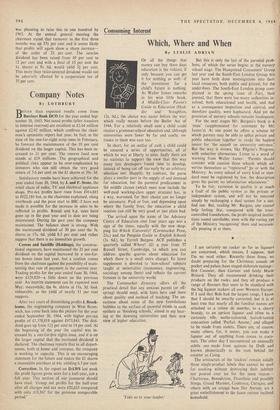Consuming Interest
Which, Where and When
By LESLIE ADRIAN
OF all the things' that money can buy these days education is the riskiest, if only because you can get it for nothing as well—if the investment for a child's future is nothing. As Walter James remarks in his wise little book, A Middle-Class Parents Guide to Education (Hod-
, • der and Stoughton, 12s. 6d.), the choice was easier before the' war; which really means before the Butler Act of 1944. For a relatively small sum' a child could receive a grammar-school education and, although universities were fewer by far and costly, en- trance to them was easy too.
In short, for an outlay of cash a child could be ensured a series of opportunities, all of which he was at liberty to miss. Sadly there are no statistics to support the view that this way many late developers found time to develop, instead of being cut off too' early by an arbitrary selection' test. Happily, by contrast, the purse plays a smaller part in the supply of and demand for education, but the parental predicament in the middle classes (which must now include the well-paid working-class upper stratum) has, in way, worsened, for their choice can no longer be automatic. Paid or free, and depending upon where the family lives,' the education a child receives can still be very good or just plain bad.
The arrival upon the scene of 'the Advisory Centre of Education over four years ago was 'a sign of the times, equally with the new shop-' ping list .Which University? (Cornmarket Press, 21s.) and the Penguin Guide to English Schools (3s. 6d.), by Tyrrell Burgess. ACE publishes a quarterly called Where? (El a year from 57 Russell Street, Cambridge, to which you can address specific queries about education for which there is a small extra charge). Its latest, supplement is devoted to `non-school' subjects taught at universities (economics, engineering, sociology among them) and reflects the current ferment in the university world.
The Cornmarket directory offers all the practical detail that any anxious parent (or off- spring) should need, with hints here and there about quality and method of teaching. The un- easiness about some of the new foundations bubbles to the surface of parental minds in such epithets as 'finishing schools,' aimed in my hear- ing at the dawning universities and their new view of higher education.
'Take us to your leader.' But this is 'only the last of the parental prob- lems, of which the series begins at the nursery school stage. The Hampstead Consumers' Group last year and the South-East London Group this
year have both done investigations into their•local resources, both public and private, for the under-fives. The South-East London group com- plained in the spring issue of Fact, their journal, that there were too many authorities in- volved, both educational and health, and that as a consequence inspection and control, and therefore quality, were haphazard. And yet the provision of nursery schools remains inadequate.
For the next stages Mr. Burgess's book is a `must' (supplemented for comment by Mr.
James's). At one point he offers a scheme by which parents may be able to splice private and public education together to ready the hapless junior for `the assault on university entrance.' But the way is strewn, like Pilgrim's Progress, with seductive alternatives. Listen to a word of warning from Walter •James: 'Parents should consider with caution those .schools which ad- vertise themselves as "registered" by or with the Ministry. As every school of every kind or stan- dard must be registered by law, the description gives the parent no information whatsoever.'
To be fair, variation in quality is as much a fault of the public system as the • private or independent system, and will not be removed simply by exchanging a dual system for a uni- fied one. But, reading Mr. Burgess, one cannot help feeling that, compared with the trust- controlled foundations, the profit-inspired institu- tions sound unreliable, even with the roving eye of the Ministry 'recognising' them, and occasion- ally peeping in at them.
I am certainly, no rocker as far as liqueurs are concerned, which means, I suppose, that I'm no mod either. Recently three firms, no doubt preparing for the Christmas assault on pocket and palate, have staged elaborate tastings : first Cusenier, then Garnier and lately Marie Brizard. They all recommend drinking their products on the rocks, and they all produce a range of flavours that seem to be standard with the big liqueur makers all over Western Europe. If I said that Bols had the largest range, I know that I should be smartly corrected, but it is at least true that nearly all the familiar names are attached to a creme de menthe, to a cherry brandy, to an apricot liqueur and often to a curiously vile, meths-coloured, hairoil-tasting concoction called 'Parfait Amour,' and alleged to be made from violets. There are, of course, 'many others, for, it seems, you can make a liqueur out of anything from cocoa to coco- nuts. The'other day I encountered an unusually subtle one made from quinces by Dolfi and known phonetically to the men behind • the counter as Coing.
The aristocrats of the `stickieS' remain solidly those single-product labels that cannot be used for cooking without destroying their subtlety nor poured over ice for the same reason— Chartreuse, Benedictine, Drambuie and possibly Stivga. Grand Marnier, Cointreau, Curacao, and others with an orange base like Aurum, are a great embellishment to the haute cuisine inclined household.


































 Previous page
Previous page